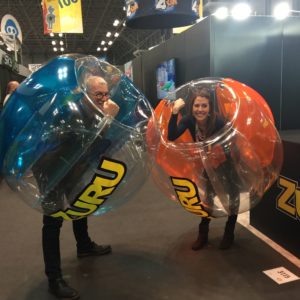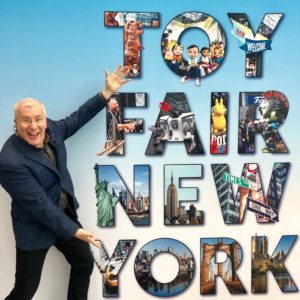Today’s global toy business is a distinctly modern phenomenon. The first New York Toy Fair in 1903 was nowhere near the massive show that it is today. In fact, the American toy industry was virtually non-existent. Many, if not most, toys were home made, or locally crafted. Real toys came from Europe. In those early days of domestic toy manufacturing, representatives of U.S. companies tried to meet with buyers before or after their European trips. Before the toy industry as more organized, people trying to sell toys would actually try to meet buyers right on the docks in New York City.

In those early days, as the population grew and the novel concept of leisure time (for kids as well as adults) took hold, there was more time for things like play. The shift from an agrarian to an industrial society literally created modern childhood. With the luxury or time, and not unimportantly, increasing life expectancy, children were free to be young longer and take up adult responsibilities later in life. Over the forty years from that first show in 1903, the toy industry would become more centered in the U.S. and much more sophisticated.
Some of the big stars of the 1903 season were crayons…in color! Binney & Smith introduced their original 8-pack of crayons. Lionel Trains miniaturized the major means of transport in the country, and in later years, toy versions of that amazing new invention the motor car, captured children’s imaginations. Erector Sets, Tinkertoys, and Lincoln Logs are just a few of the still-made, classic toys that were new in those years.
Toy Fair continued to grow in influence and importance over the years. American toys were really arriving. A.C. Gilbert, one of the founders of the Toy Association said in 1919, “The word ‘toys’ does not mean ‘made in Germany.'” In 1939, a whopping 1,700 buyers registered for the show that ran for two weeks at the end of April. and it was one of the first years that buyers from Europe came to New York. Toys were becoming increasingly important in the culture, not just as a business. In 1930, one of the first studies of toys and play were published, and educators and the culture at large were acknowledging how important play was in the lives of children.
In the past year, we’ve heard a lot about the impact of tariffs. What might not be so effective for a globally integrated business was essential to the protection of a U.S.-only business. Fears that foreign manufacturers would dump cheap goods on the American market (and not just in toys), prompted the Tariff Act of 1922 that effectively protected the still growing U.S businesses. The the Toy Manufacturers’ Association, founded in 1916, actively worked with government to protect domestic business, and tariffs would play another role in protecting manufacturing in 1930, after World War II, and the Korean War.

All the while the industry continued to grow and expand, with Toy Fair a highlight of every winter or spring. (The dates have moved around quite a bit over the years.) The only year that Toy Fair didn’t happen was 1945, when scarce resources and fears about travel prompted the government to ask the toy industry, and others, to cancel trade shows.
After World War II, plastics developed for the war effort were turned to peacetime use, including toys. Metal fabrication plants that had been cranking out munitions began to make swing sets and bicycles, the new fixtures on the landscape in booming suburbia. This new generation of kids needed playthings, and manufacturers were only too happy to supply them. The industry moved largely into 200 Fifth Avenue (aka The Toy Center), at the corner of 23rd and 5th Avenue. The building, which had once been an elegant hotel, and by 1960 was filled exclusively with toy showrooms. By 1981, more than 600 companies would call that building home, and it would remain so until 2000 when Toy Fair moved into the Javits Center on New York’s West Side.
From the 60s to the 90s, Toy Fair was national news. Reporters came from all over to see the latest toys, be wined and dined and attend lavish parties. It wasn’t just a time to sell what was new, it was a celebration of an entire industry. The streets around The Toy Center would be filled with trucks, costumed characters, the more outrageous the better. I was working with Ideal on a game called Murder To Go, and we sprayed body outlines on the street around the show, as if some dastardly crime had been committed. Of course it was completely illegal, but it was a stunt we did in the middle of the night, and, luckily, we got away with it. During those years, Toy Fair was a global event, and people came from all over the world. Part of the thrill was that international travelers got a first look at what would come to them the following year. Today, things are launched globally almost at the same time.
Fast forw ard to today. Toy Fair has taken over the Javits Center completely with 25,000 visitors from more than 100 countries and covering more area than eight football fields.

It’s still as exciting as ever! Over the years toys have certainly changed, but people haven’t Whether powered by a computer, using advanced technology or simply a playing card, the most valuable and important play experiences will be those that inspire an individual child’s imagination. At the end of the day, the ability to connect to the imagination will always be what creates the best toys, for it is the imagination that connects us to our pasts…and our futures.
Finding those is what Toy Fair is all about! I can’t wait.

